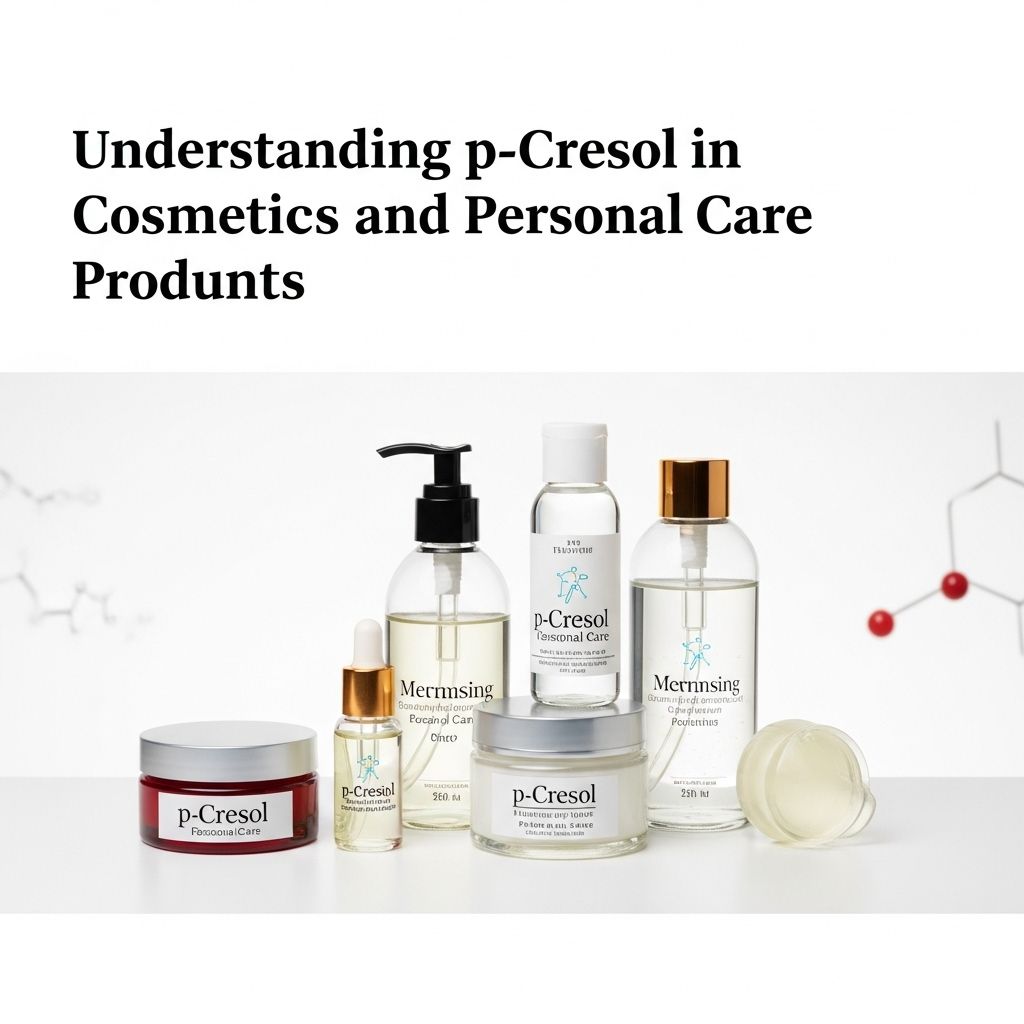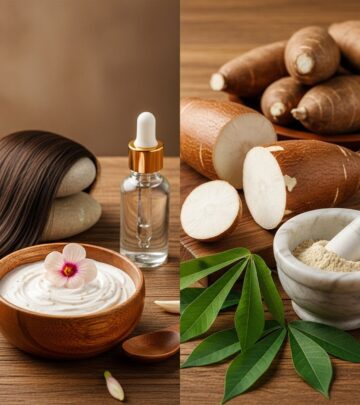Understanding p-Cresol in Cosmetics and Personal Care Products
Explore the uses, safety, and regulation of p-Cresol in cosmetics and personal care applications, including expert panel assessments.

p-Cresol is a chemical ingredient used in various cosmetic and personal care products, often as a biocide, preservative, or fragrance component. Its use and safety have been assessed by scientific panels, with particular attention to its effects on skin and health. This article provides an in-depth overview of p-Cresol, including its definition, uses, safety considerations, regulatory status, and guidance for consumers.
What Is p-Cresol?
Cresols are aromatic organic compounds with the formula C7H8O. They occur in three isomeric forms: o-cresol, m-cresol, and p-cresol, distinguished by the position of the methyl group relative to the hydroxyl group on the benzene ring. p-Cresol (para-cresol) is specifically 4-methylphenol and generally appears as crystals at room temperature.
Cresol and its derivatives (such as p-Chloro-m-Cresol, m-Cresol, o-Cresol, p-Cresol) and related isopropyl cresols (e.g., Chlorothymol, Thymol, o-Cymen-5-ol, Carvacrol) can all be used as ingredients in cosmetic and personal care formulations.
Chemical Properties of p-Cresol
- Chemical name: 4-methylphenol or para-cresol
- Molecular formula: C7H8O
- Physical form: White to yellowish crystals (can vary with purity and storage)
p-Cresol is a component of mixed cresols and occurs in some natural products. It is synthesized for use in various applications, including as an intermediate in chemical manufacturing, and as a biocidal agent in formulations.
Why Is p-Cresol Used in Cosmetics and Personal Care Products?
In cosmetics and personal care products, p-Cresol and related cresols have two main functional uses:
- As biocides/preservatives: These chemicals prevent the growth of harmful microorganisms in products, thereby protecting product integrity and extending shelf life.
- As fragrance ingredients: Cresols may be included in formulas for their characteristic phenolic odor profile, contributing to the overall scent.
p-Cresol and similar ingredients can be found in a variety of products, including:
- Bath products
- Skin and body lotions
- Personal care items
- Hair products and dyes
- Mouthwashes
Safety Assessment of p-Cresol by the CIR Expert Panel
The Cosmetic Ingredient Review (CIR) Expert Panel critically evaluates the safety of cosmetic ingredients based on available scientific data, regulatory information, and toxicological studies. Below are the main findings concerning p-Cresol:
Toxicity and Safe Use Limitations
- Toxic effects of cresol and isopropyl cresol ingredients have been observed at doses higher than those typically used in cosmetic products.
- To ensure safety, the CIR Expert Panel recommended an upper concentration limit for these ingredients in cosmetic formulations.
- Research indicates that m-Cresol and o-Cresol at 0.5% do not cause chemical leukoderma (depigmentation of the skin)
- For ingredients like Sodium p-Chloro-m-Cresol, p-Chloro-m-Cresol, Chlorothymol, and other related compounds, a concentration limit of 0.5% is considered adequately safe to prevent skin whitening effects.
Concerns Specific to p-Cresol and Mixed Cresols
- p-Cresol was shown to cause depigmentation of hair and possibly the skin (chemical leukoderma) at certain concentrations.
- There is evidence suggesting that p-Cresol may be a strong allergen in some individuals, raising concerns about potential sensitization or allergic skin reactions.
- The CIR Panel found insufficient data to determine a safe concentration of p-Cresol or Mixed Cresols that would not cause sensitization or skin lightening when used in cosmetics.
Due to these factors, the CIR Expert Panel concluded:
- There is insufficient data to support the unrestricted safe use of p-Cresol and Mixed Cresols in cosmetics at current or typical concentrations.
- Additional studies are required to demonstrate safe concentrations of use that would not result in adverse effects, particularly skin whitening and sensitization.
Regulatory Guidelines
United States
- The US Food and Drug Administration (FDA) recognizes the use of some cresol derivatives (such as thymol) as antimicrobial preservatives in regulated applications.
- Manufacturers must ensure ingredient concentrations do not exceed safety limits as determined by toxicological evaluation and industry guidance.
- For p-Cresol specifically, a safe upper limit has not been established due to insufficient safety data regarding sensitization and depigmentation effects.
European Union
- The European Union Cosmetic Regulation permits the use of certain preservatives at established concentrations listed in Annex VI of the regulation.
- For example:
- p-Chloro-m-Cresol and Sodium p-Chloro-m-Cresol are permitted up to 0.2% as preservatives in cosmetic products.
- o-Cymen-5-ol (4-Isopropyl-m-cresol) is allowed up to 0.1% as a preservative.
- p-Cresol per se is not included in the allowed preservatives list due to lack of sufficient safety data.
Read more about EU Cosmetic Regulations
Other Regulatory References
- Chemicals used in cosmetics are subject to scrutiny in various jurisdictions and must adhere to local and international safety standards.
Potential Health Effects and Toxicology
The toxicological profile of p-Cresol and related compounds is detailed by the CIR Panel and other agencies. Key points include:
- At higher-than-cosmetic concentrations, cresols can cause irritation, depigmentation (loss of skin or hair pigment), and allergic reactions.
- The NOAEL (No-Observed-Adverse-Effect Level) has not been solidly established for p-Cresol in the context of cosmetic use on the skin.
- Some derivatives (m-Cresol and o-Cresol) are shown to be safe at ≤0.5%, but similar assertions cannot be made for p-Cresol or mixed cresols without more extensive data.
- Chemical leukoderma, an acquired form of skin depigmentation, is a particular risk associated with p-Cresol exposure at certain levels.
Summary Table: Allowed Concentrations of Selected Preservatives (EU)
| Ingredient | Function | Max Allowed Concentration (EU) |
|---|---|---|
| p-Chloro-m-Cresol | Preservative | 0.2% |
| Sodium p-Chloro-m-Cresol | Preservative | 0.2% |
| o-Cymen-5-ol (4-Isopropyl-m-cresol) | Preservative | 0.1% |
| m-Cresol, o-Cresol | Preservative | 0.5% |
| p-Cresol, Mixed Cresols | Preservative/Fragrance | Not established |
Consumer Guidance and Industry Best Practice
- Read product ingredient labels, especially if you have known sensitivities to phenolic compounds or preservatives.
- Be alert to skin changes, such as unexpected depigmentation or allergic reactions, and discontinue use if symptoms occur.
- Trust reputable brands that comply with regulatory and CIR guidance regarding ingredient safety.
- Recognize that the absence of adverse effects at lower concentrations of certain cresols does not guarantee safety for all derivatives like p-Cresol itself.
- If you have allergies or medical conditions, consult with a dermatologist before using products containing cresolic ingredients.
Frequently Asked Questions (FAQs) about p-Cresol
Q: What is p-Cresol, and why is it used in cosmetics?
A: p-Cresol is one form of cresol, an aromatic organic compound. In cosmetics, it is primarily used for its preservative/biocidal and fragrance properties. It helps prevent microbial growth, which maintains product safety and quality.
Q: Can p-Cresol cause skin reactions or allergies?
A: Yes, p-Cresol has been identified as a potential allergen and may sensitize some users, causing skin reactions. There are also concerns about skin depigmentation (whitening) at certain concentrations.
Q: Are cresols safe in cosmetic products?
A: Some cresols (e.g., m-Cresol, o-Cresol) are considered safe when used within established concentration limits (up to 0.5%). For p-Cresol, safety at typical cosmetic concentrations has not been sufficiently demonstrated, so its unrestricted use is not currently supported.
Q: Are there regulations on cresol use in cosmetics?
A: Yes. The European Union allows certain cresol derivatives as preservatives within strict concentration limits. The US FDA and other authorities review safety data, but p-Cresol itself lacks an established maximum for safe use due to data gaps.
Q: How can consumers avoid potential reactions to cresols?
A: Check ingredient labels, look for alternate names of cresol derivatives, and discontinue use if you notice adverse skin effects. If in doubt, consult a healthcare professional.
Related Regulatory and Safety Resources
For more technical queries, consult regulatory documents and safety assessment reports from reputable agencies or panels, such as the CIR, FDA, and EU regulatory bodies. Consumers and industry professionals are encouraged to stay informed as further research and evaluations are published.
Read full bio of Sneha Tete











